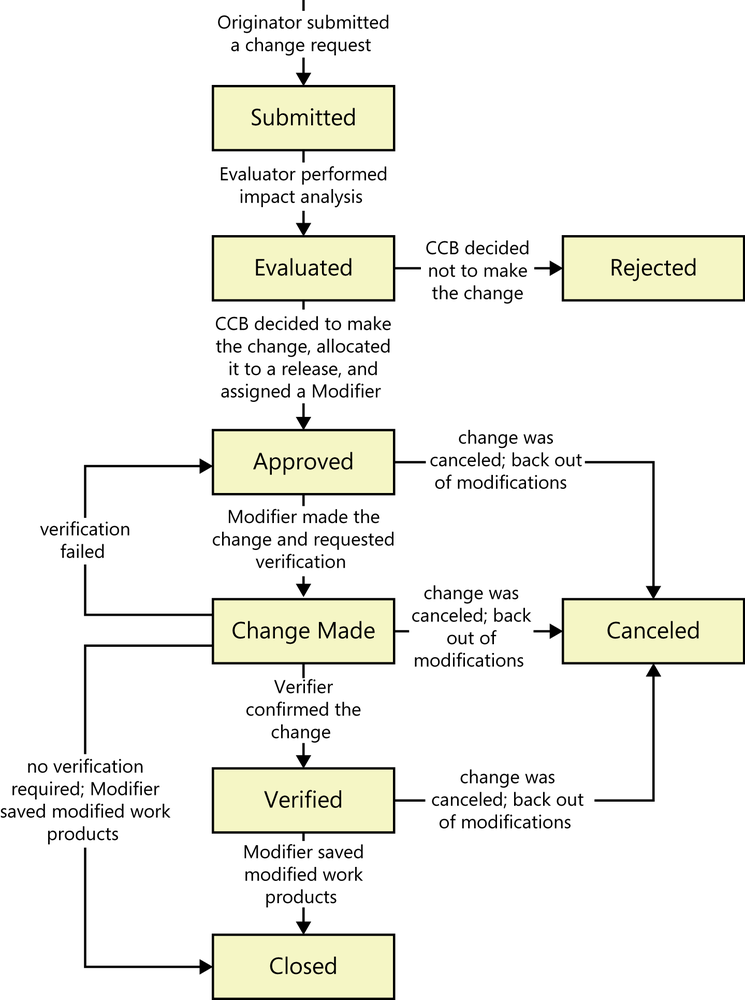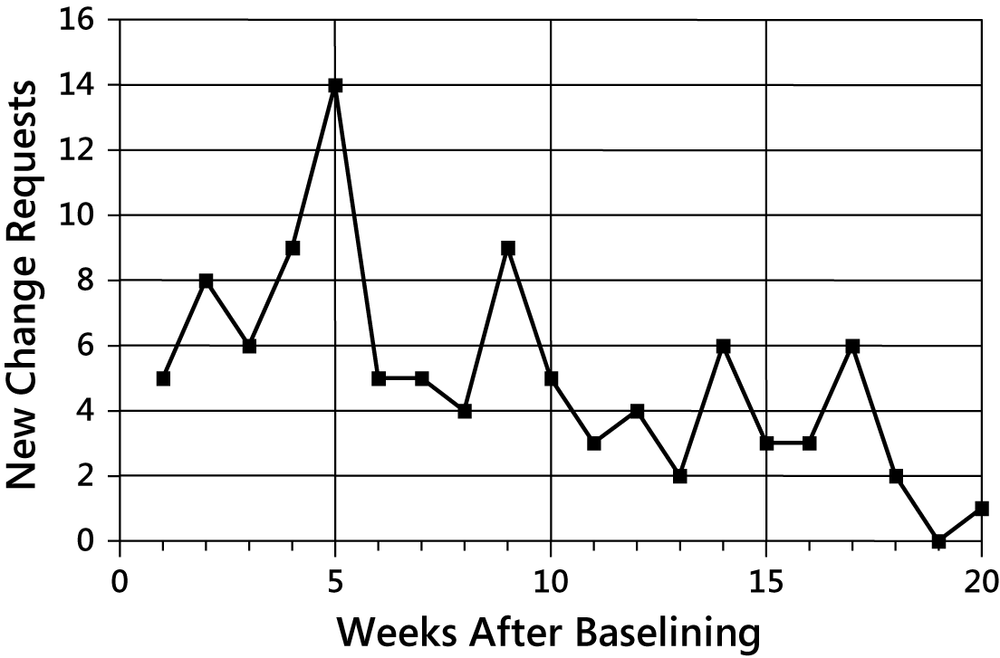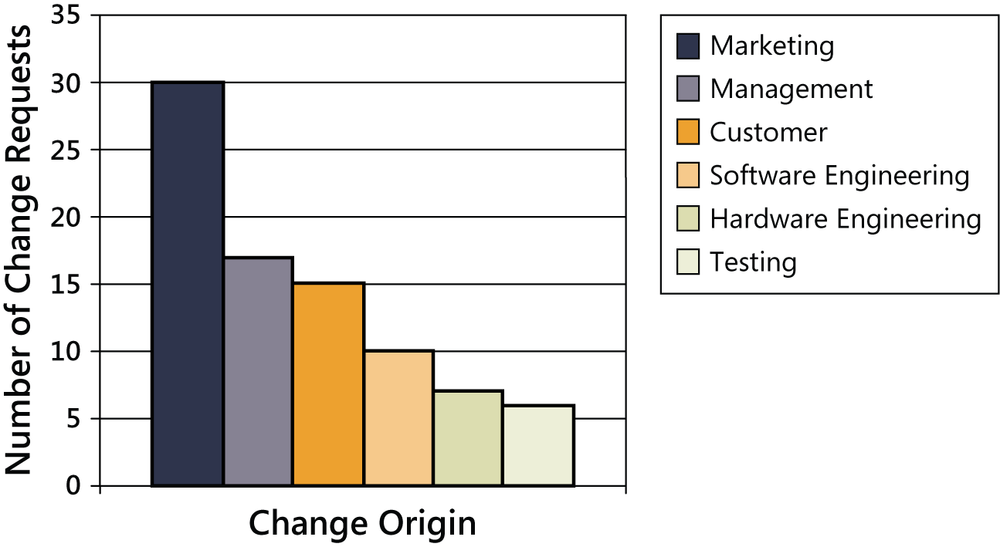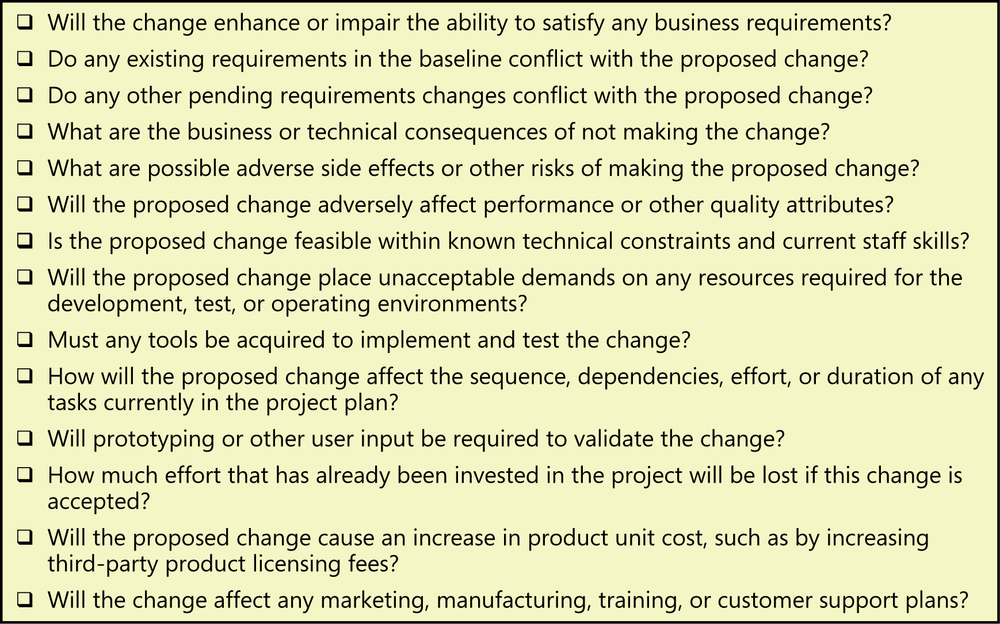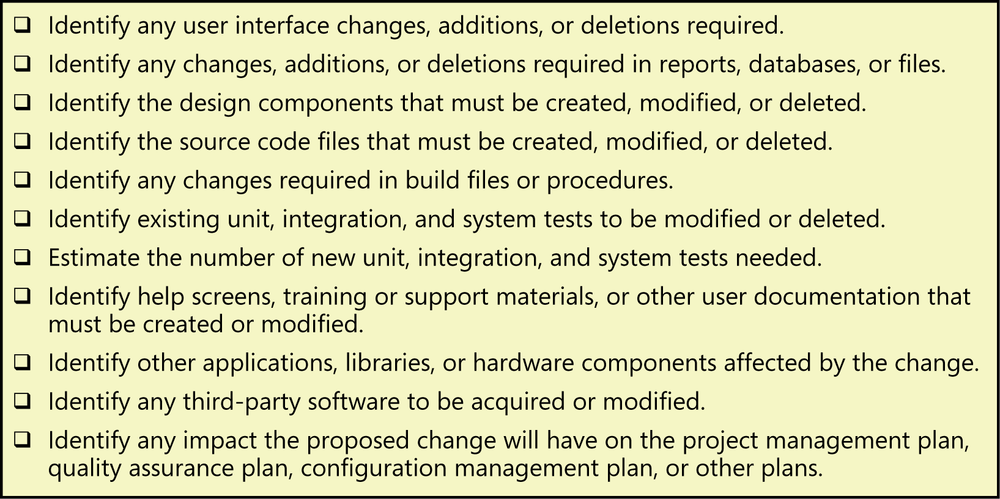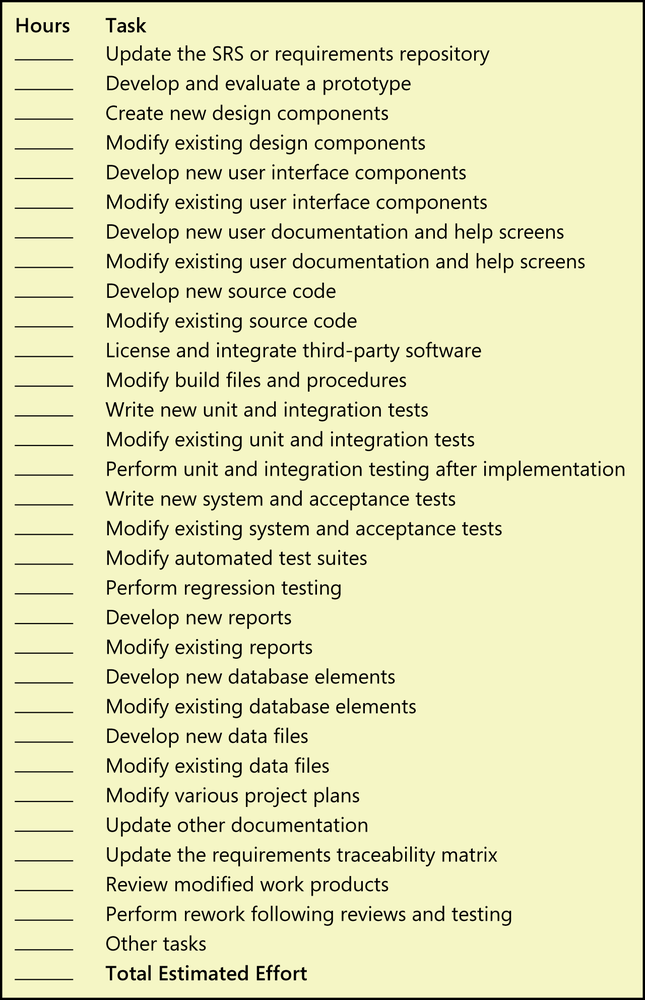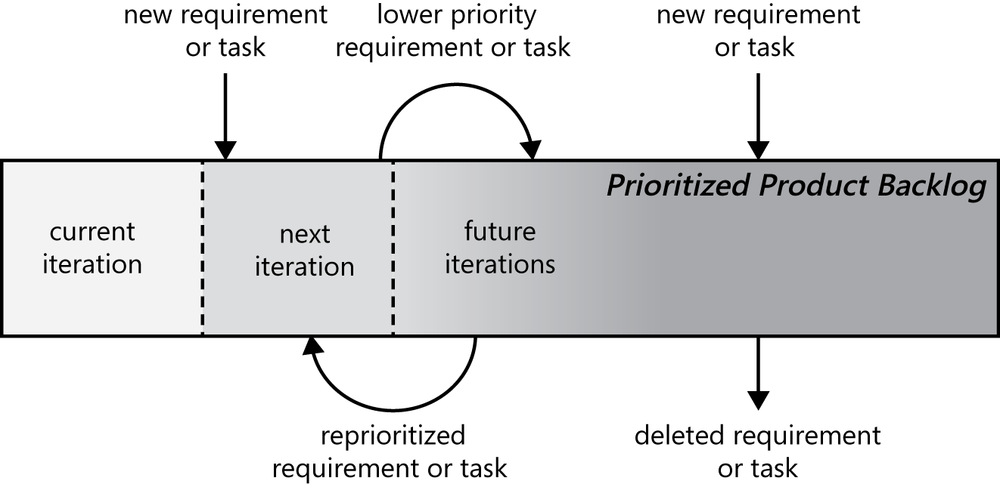Chapter 28. Change happens
“How’s your development work coming, Glenn?” asked Dave, the Chemical Tracking System’s project manager, during a status meeting.
“I’m not as far along as I’d planned to be,” Glenn admitted. “I’m adding a new catalog query function for Harumi, and it’s taking a lot longer than I expected.”
Dave was puzzled. “I don’t remember hearing about a new catalog query function. Did Harumi submit that request through the change process?”
“No, she approached me directly with the suggestion,” said Glenn. “It seemed pretty simple, so I told her I’d work it in. It turned out not to be simple at all! Every time I think I’m done, I realize I missed a change needed in another file, so I have to fix that, rebuild the component, and test it again. I thought this would take about six hours, but I’ve spent almost three days on it so far. I know I’m holding up the next build. Should I finish adding this query function or go back to what I was working on before?”
Most developers have encountered an apparently simple change that turned out to be far more complicated than expected. Developers sometimes don’t—or can’t—produce realistic estimates of the cost and other ramifications of a proposed software change. Additionally, when developers who want to be accommodating agree to add enhancements that users request, requirements changes slip in through the back door instead of being approved by the right stakeholders. Such uncontrolled change is a common source of project chaos, schedule slips, quality problems, and hard feelings. This chapter describes both formal change control practices and how agile projects incorporate changes.
Why manage changes?
Software change isn’t a bad thing; in fact, it’s necessary. It’s virtually impossible to define all of a product’s requirements up front. The world changes as development progresses: new market opportunities arise, regulations and policies change, and business needs evolve. An effective software team can nimbly respond to necessary changes so that the product they build provides timely customer value. An organization that’s serious about managing its software projects must ensure that:
Proposed requirements changes are thoughtfully evaluated before being committed to.
Appropriate individuals make informed business decisions about requested changes.
Approved changes are communicated to all affected participants.
The project incorporates requirements changes in a consistent and effective fashion.
But change always has a price. Revising a simple webpage might be quick and easy; making a change in an integrated circuit design can cost tens of thousands of dollars. Even a rejected change request consumes the time needed to submit, evaluate, and decide to reject it. Unless project stakeholders manage changes during development, they won’t really know what will be delivered, which ultimately leads to an expectation gap.
Problems can also arise if a developer implements a requirement change directly in the code without communicating with other team members. The documented requirements then become an inaccurate representation of what the product does. The code can become brittle if changes are made without respecting the architecture and design structure. On one project, developers introduced new and modified functionality that the rest of the team didn’t discover until system testing. They didn’t expect that functionality, and they didn’t know how to test it. This required unplanned rework of test procedures and user documentation. Consistent change control practices help prevent such problems and the associated frustration, rework, and wasted time.
Managing scope creep
In an ideal world, you would document all of a new system’s requirements before beginning construction, and they’d remain stable throughout the development effort. This is the premise behind the pure waterfall development model, but it doesn’t work well in practice. At some point, you must freeze the requirements for a specific release or development iteration or you’ll never finish it. However, stifling change prematurely ignores the realities that customers aren’t always sure what they need, business needs change, and developers want to respond to those changes.
Requirements growth includes new functionality and significant modifications that are presented after a set of requirements has been baselined (see Chapter 2). The longer a project goes on, the more growth it experiences. The requirements for software systems typically grow between 1 percent and 3 percent per calendar month ([ref133]). Some requirements evolution is legitimate, unavoidable, and even advantageous. Scope creep, though, in which the project continuously incorporates more functionality without adjusting resources, schedules, or quality goals, is insidious. The problem is not that requirements change but that late changes can have a big impact on work already performed. If every proposed change is approved, it might appear to stakeholders that the software will never be delivered—and indeed, it might not.
The first step in managing scope creep is to document the business objectives, product vision, project scope, and limitations of the new system, as described in Chapter 5. Evaluate every proposed requirement or feature against the business requirements. Engaging customers in elicitation reduces the number of requirements that are overlooked. Prototyping helps to control scope creep by helping developers and users share a clear understanding of user needs and prospective solutions. Using short development cycles to release a system incrementally provides frequent opportunities for adjustments.
The most effective technique for controlling scope creep is the ability to say “no” ([ref239]). People don’t like to say “no,” and development teams can receive intense pressure to always say “yes.” Philosophies such as “the customer is always right” or “we will achieve total customer satisfaction” are fine in the abstract, but you pay a price for them. Ignoring the price doesn’t alter the fact that change is not free. The president of one software tool vendor is accustomed to hearing the development manager say “not now” when he suggests a new feature. “Not now” is more palatable than a simple rejection. It holds the promise of including the feature in a subsequent release.
Trap
Freezing the requirements for a new system too soon after initial elicitation activities is unwise and unrealistic. Instead, establish a baseline when you think a set of requirements is well enough defined for construction to begin, and then manage changes to minimize their adverse impact on the project.
Change control policy
Management should communicate a policy that states its expectations of how project teams will handle proposed changes in requirements and all other significant project artifacts. Policies are meaningful only if they are realistic, add value, and are enforced. The following change control policy statements can be helpful:
All changes must follow the process. If a change request is not submitted in accordance with this process, it will not be considered.
No design or implementation work other than feasibility exploration will be performed on unapproved changes.
Simply requesting a change does not guarantee that it will be made. The project’s change control board (CCB) will decide which changes to implement.
The contents of the change database must be visible to all project stakeholders.
Impact analysis must be performed for every change.
Every incorporated change must be traceable to an approved change request.
The rationale behind every approval or rejection of a change request must be recorded.
Of course, tiny changes will hardly affect the project, and big changes will have a significant impact. In practice, you might decide to leave certain requirements decisions to the developers’ discretion, but no change affecting more than one individual’s work should bypass your process. Include a “fast path” to expedite low-risk, low-investment change requests in a compressed decision cycle.
Basic concepts of the change control process
When performing a software process assessment, I asked a project team how they handled requirements changes. After an awkward silence, one person said, “Whenever the marketing representative wants to make a change, he asks Bruce or Robin because they always say ‘yes.’ The rest of us push back about changes.” This didn’t strike me as a great change process.
A sensible change control process lets the project’s leaders make informed business decisions that will provide the greatest customer and business value while controlling the product’s life-cycle cost and the project’s schedule. The process lets you track the status of all proposed changes, and it helps ensure that suggested changes aren’t lost or overlooked. After you’ve baselined a set of requirements, you should follow this process for all proposed changes to that baseline.
Stakeholders sometimes balk at being asked to follow a new process, but a change control process is not an obstacle to making necessary modifications. It’s a funneling and filtering mechanism to ensure that the project expeditiously incorporates the most appropriate changes. If a proposed change isn’t important enough for a stakeholder to take just a couple of minutes to submit it through a standard, simple channel, then it’s not worth considering for inclusion. Your change process should be well documented, as simple as possible, and—above all—effective.
Trap
If you ask your stakeholders to follow a new change control process that’s ineffective, cumbersome, or too complicated, people will find ways to bypass the process—and they should.
Managing requirements changes is similar to the process for collecting and making decisions about defect reports. The same tools can support both activities. Remember, though: a tool is not a substitute for a documented process, and neither one is a substitute for appropriate discussions between stakeholders. Regard both a tool and a written process as ways to support these critical conversations.
When you need to incorporate a change, start at the highest level of abstraction that the change touches and cascade the change through affected system components. For example, a proposed change might affect a user requirement but not any business requirements. Modifying a high-level system requirement could affect numerous software and hardware requirements in multiple subsystems. Some changes pertain only to system internals, such as the way a communication service is implemented. These aren’t user-visible requirements changes, but rather design or code changes.
A change control process description
Figure 28-1 illustrates a template for a change control process description to handle requirements modifications. A sample change control process description is available for downloading from this book’s companion content website. If this template is too elaborate for your environment, scale it down for more informal projects. We find it helpful to include the following four components in all process descriptions:
Entry criteria, the conditions that must be satisfied before the process execution can begin
The various tasks involved in the process, the project role responsible for each task, and other participants in the task
Steps to verify that the tasks were completed correctly
Exit criteria, the conditions that indicate when the process is successfully completed
The rest of this section describes the various sections in the change control process description.
1. Purpose and scope
Describe the purpose of this process and the organizational scope to which it applies. Indicate whether any specific kinds of changes are exempted, such as changes in interim work products. Define any terms that are necessary for understanding the rest of the document.
2. Roles and responsibilities
List the project team roles that participate in the change control activities and describe their responsibilities. Table 28-1 suggests some pertinent roles; adapt these to each project situation. Different individuals need not be required for each role. For example, the CCB Chair might also receive submitted change requests. The same person can fill several—perhaps all—roles on a small project. As one experienced project manager put it, “What I find important is that the representation of the CCB needs to be able to speak to the needs of the diverse stakeholders, including the end users, the business, and the development community: do we need it, can we sell it, can we build it?”
Role | Description and responsibilities |
CCB Chair | Chairperson of the change control board; generally has final decision-making authority if the CCB does not reach agreement; identifies the Evaluator and the Modifier for each change request |
CCB | The group that decides to approve or reject proposed changes for a specific project |
Evaluator | Person whom the CCB Chair asks to analyze the impact of a proposed change |
Modifier | Person who is responsible for making changes in a work product in response to an approved change request |
Originator | Person who submits a new change request |
Request Receiver | Person who initially receives newly submitted change requests |
Verifier | Person who determines whether the change was made correctly |
3. Change request status
A change request passes through a defined life cycle of states. You can represent these states by using a state-transition diagram (see Chapter 12), as illustrated in Figure 28-2. Update a request’s status only when the specified transition criteria are met. For instance, you can set the state to “Change Made” after all affected work products have been modified to implement the change, whether that is just a single requirement statement or a set of related development work products.
4. Entry criteria
The basic entry criterion for your change control process is that a change request with all the necessary information has been received through an approved channel. All potential originators should know how to submit a change request. Your change tool should assign a unique identifier to each request and route all changes to the Request Receiver.
5. Tasks
This section of the process describes the tasks that are performed to handle a single change request.
5.1 Evaluate change request
Begin by evaluating the request for technical feasibility, cost, and alignment with the project’s business requirements and resource constraints. The CCB Chair might assign an Evaluator to perform impact analysis, risk and hazard analysis, or other assessments. (See the “Change impact analysis” section later in this chapter.) This ensures that the consequences of accepting the change are understood. The Evaluator and the CCB should also consider the business and technical implications, if any, of rejecting the request.
5.2 Make change decision
The appropriate decision makers, chartered as the CCB, then decide whether to approve or reject the change. The CCB gives each approved change a priority or target implementation date, or it allocates the change to a specific iteration or release. It might simply add a new requirement to the product backlog of pending work. The CCB updates the request’s status and notifies all affected team members.
5.3 Implement the change
The assigned Modifier (or Modifiers) updates the affected work products as necessary to fully implement the change. Use requirements trace information to find all the parts of the system that the change touches, and revise the trace information if necessary to reflect the changes made.
5.4 Verify the change
Requirements changes typically are verified through a peer review to ensure that modified deliverables correctly address all aspects of the change. Multiple team members might verify the changes made in various downstream work products through testing or review. After verification is complete, the Modifier stores updated work products in the appropriate locations per the project’s document and code management conventions.
6. Exit criteria
Satisfying the following exit criteria indicates that an execution of your change control process was properly completed:
The status of the request is Rejected, Closed, or Canceled.
All modified work products are updated and stored in the correct locations.
The relevant stakeholders have been notified of the change details and the status of the change request.
7. Change control status reporting
Identify the charts and reports you’ll use to summarize the contents of the change database. These charts might show the number of change requests in each state as a function of time, or trends in the average time that a change request is unresolved. Describe the procedures for producing the charts and reports. The project manager uses these reports when tracking the project’s status.
Appendix: Attributes stored for each request
Table 28-2 lists some data attributes to consider storing for each change request. Some of these items are supplied by the Originator and some by the CCB. In your change control process, indicate which attributes are required and which are optional. Don’t define more attributes than you really need. Your change tool should handle some of these (ID, date submitted, date updated) automatically.
Item | Description |
Change origin | Functional area that requested the change; possible groups include marketing, management, customer, development, and testing |
Change request ID | Unique identifier assigned to the request |
Change type | Type of change request, such as requirement change, proposed enhancement, or defect report |
Date submitted | Date the Originator submitted the change request |
Date updated | Date the change request was most recently modified |
Description | Free-form text description of the change being requested |
Implementation priority | The relative importance of making the change as determined by the CCB: low, medium, or high |
Modifier | Person who is primarily responsible for implementing the change |
Originator | Person who submitted this change request |
Originator priority | The relative importance of making the change from the Originator’s point of view: low, medium, or high |
Planned release | Product release or iteration for which an approved change is scheduled |
Project | Name of the project in which a change is being requested |
Response | Free-form text of responses made to the change request; multiple responses can be made over time; do not change existing responses when entering a new one |
Status | The current status of the change request, selected from the options in Figure 28-2 |
Title | One-line summary of the proposed change |
Verifier | Person who is responsible for determining whether the change was made correctly |
The change control board
The change control board is the body of people—whether it is one individual or a diverse group—that decides which proposed changes and new requirements to accept, which to accept with revisions, and which to reject. The CCB also decides which reported defects to correct and when to correct them. Some CCBs are empowered to make decisions, whereas others can only make recommendations for management decision. Projects always have some de facto group that makes change decisions. Establishing a CCB formalizes this group’s composition and authority and defines its operating procedures.
To some people, the term “change control board” conjures an image of wasteful bureaucratic overhead. Instead, think of the CCB as providing a valuable structure to help manage even a small project. On a small project, it makes sense to have only one or two people make the change decisions. Very large projects or programs might have several levels of CCBs, some responsible for business decisions, such as requirements changes, and some for technical changes. A large program that encompasses multiple projects would establish a program-level CCB and an individual CCB for each project. Each project CCB resolves issues and changes that affect only that project. Issues that affect multiple projects and changes that exceed a specified cost or schedule impact are escalated to the program-level CCB.
CCB composition
The CCB membership should represent all groups who need to participate in making decisions within the scope of that CCB’s authority. Consider selecting representatives from the following areas:
Project or program management
Business analysis or product management
Development
Testing or quality assurance
Marketing, the business for which the application is being built, or customer representatives
Technical support or help desk
Only the subset of these people who need to make the decisions will be part of the CCB, although all stakeholders must be informed of decisions that affect their work. The CCB for a project with both software and hardware components might also include representatives from hardware engineering, systems engineering, and/or manufacturing. Keep the CCB small so the group can respond promptly and efficiently to change requests. Make sure the CCB members understand and accept their responsibilities. Invite other individuals to CCB meetings as necessary to ensure that the group has adequate technical and business information.
CCB charter
All of the project teams in an organization can follow the same change control process. However, their CCBs might function in different ways. Each project should create a brief charter (which could be part of the project management plan) that describes its CCB’s purpose, scope of authority, membership, operating procedures, and decision-making process ([ref224]). A template for a CCB charter is available for downloading from this book’s companion content website. The charter should state the frequency of regularly scheduled CCB meetings and the conditions that trigger a special meeting or decision. The scope of the CCB’s authority indicates which decisions it can make and which ones it must escalate.
Making decisions
Each CCB needs to define its decision-making process, which should indicate:
The number of CCB members or the key roles that constitute a decision-making quorum.
The decision rules to be used (see Chapter 2 for more about decision rules).
Whether the CCB Chair can overrule the CCB’s collective decision.
Whether a higher level of CCB or management must ratify the group’s decision.
The CCB balances the anticipated benefits against the estimated impact of accepting a proposed change. Benefits from improving the product could include financial savings, increased revenue, higher customer satisfaction, and competitive advantage. Possible negative impacts include increased development and support costs, delayed delivery, and degraded product quality.
Communicating status
After the CCB makes its decision, a designated individual updates the request’s status in the change database. Some tools automatically generate an email message to communicate the new status to the Originator who proposed the change and to others affected by the change. If an email message is not generated automatically, inform the affected people so they can respond to the change.
Renegotiating commitments
Stakeholders can’t stuff more and more functionality into a project that has schedule, staff, budget, or quality constraints and still expect to succeed. Before accepting a significant requirement change, renegotiate commitments with management and customers to accommodate the change. You might ask for more time or to defer lower-priority requirements. If you don’t obtain some commitment adjustments, document the threats to success in your project’s risk list so people aren’t surprised if there are negative outcomes.
Change control tools
Many teams use commercial issue-tracking tools to collect, store, and manage requirements changes. A report of recently submitted change requests extracted from the tool can serve as the agenda for a CCB meeting. Issue-tracking tools can report the number of requests having each state at any given time. Because the available tools, their vendors, and their features frequently change, we don’t provide specific tool recommendations here. To support your change process, look for a tool that:
Allows you to define the attributes that constitute a change request.
Allows you to implement a change request life cycle with multiple change request statuses.
Enforces the state-transition model so that only authorized users can make specific status changes.
Records the date of each status change and the identity of the person who made it.
Provides customizable, automatic email notification when an Originator submits a new request or when a request’s status is updated.
Produces both standard and custom reports and charts.
Some commercial requirements management tools have a change-request system built in. These systems can link a proposed change to a specific requirement so that the individual responsible for each requirement is notified by email whenever someone submits a pertinent change request.
Measuring change activity
Measuring change activity is a way to assess the stability of the requirements. It also reveals opportunities for process improvements that might lead to fewer changes in the future. Consider tracking the following aspects of your requirements change activity:
The total number of change requests received, currently open, and closed
The cumulative number of added, deleted, and modified requirements
The number of requests that originated from each change origin
The number of changes received against each requirement since it was baselined
The total effort devoted to processing and implementing change requests
You don’t necessarily need to monitor your requirements change activities to this degree. As with all software metrics, understand your goals and how you’ll use the data before you decide what to measure ([ref248]). Start with simple metrics to begin establishing a measurement culture in your organization and to collect the data you need to manage your projects effectively.
Figure 28-3 illustrates a way to track the amount of requirements change your project experiences during development ([ref247]). This requirements volatility chart tracks the rate at which new proposals for requirements changes arrive after a baseline was established. This chart should trend toward zero as you approach release. A sustained high frequency of changes implies a risk of failing to meet your schedule commitments. It probably also indicates that the original requirements set was incomplete; better elicitation practices might be in order.
Tracking the requirements change origins is also illuminating. Figure 28-4 shows a way to represent the number of change requests that came from different sources. The project manager could discuss a chart like this with the marketing manager and point out that marketing has requested the most requirements changes. This might lead to a fruitful discussion about actions the team could take to reduce the number of changes received from marketing in the future or better ways to handle them. Using data as a starting point for such discussions is more constructive than holding a confrontational debate fueled by emotion. Come up with your own list of possible requirements change origins.
Change impact analysis
The need for impact analysis is obvious for major enhancements. However, unexpected complications can lurk below the surface of even minor change requests. A company once had to change the text of one error message in its product. What could be simpler? The product was available in both English-language and German-language versions. There were no problems in English, but in German the new message exceeded the maximum character length allocated for error message displays in both the message box and a database. Coping with this seemingly simple change request turned out to be much more work than the developer had anticipated when he promised a quick turnaround.
Impact analysis is a key aspect of responsible requirements management ([ref010]). It provides an accurate understanding of the implications of a proposed change, which helps the team make informed business decisions about which proposals to approve. The analysis examines the request to identify components that might have to be created, modified, or discarded, and to estimate the effort required to implement the change. Before a developer says, “Sure, no problem” in response to a change request, he should spend a little time on impact analysis.
Impact analysis procedure
The CCB Chair will ask one or more technical people (business analysts, developers, and/or testers) to perform the impact analysis for a specific change proposal. Impact analysis involves three steps:
Understand the possible implications of making the change. A requirement change often produces a large ripple effect, leading to modifications in other requirements, architectures, designs, code, and tests. Changes can lead to conflicts with other requirements or can compromise quality attributes, such as performance or security.
Identify all the requirements, files, models, and documents that might have to be modified if the team incorporates the requested change.
Identify the tasks required to implement the change, and estimate the effort needed to complete those tasks.
Important
Skipping impact analysis doesn’t change the size of the task. It just turns the size into a surprise. Software surprises are rarely good news.
Figure 28-5 presents a checklist of questions to help the evaluator understand the implications of accepting a proposed change. The checklist in Figure 28-6 contains questions to help identify all software elements and other work products that the change might affect. Requirements trace information that links the affected requirement to other downstream deliverables helps greatly with impact analysis. As you gain experience in using these checklists, modify them to suit your own projects. (Note: Figure 28-5 Figure 28-6 Figure 28-7 Figure 28-8 are available for downloading from this book’s companion content website.)
Many estimation problems arise because the estimator doesn’t think of all the work required to complete an activity. Therefore, this impact analysis approach emphasizes thorough task identification. For substantial changes, use a small team—not just one developer—to do the analysis and effort estimation to avoid overlooking important tasks. Following is a simple procedure for evaluating the impact of a proposed requirement change:
Work through the checklist in Figure 28-5.
Work through the checklist in Figure 28-6. Some requirements management tools include an impact analysis report that follows traceability links and finds the system elements that depend on the requirements affected by a change request.
Use the worksheet in Figure 28-7 to estimate the effort required for the anticipated tasks. Most change requests will require only a portion of the tasks on the worksheet.
Sum the effort estimates.
Identify the sequence in which the tasks must be performed and how they can be interleaved with currently planned tasks.
Estimate the impact of the proposed change on the project’s schedule and cost.
Evaluate the change’s priority compared to other pending requirements.
Report the impact analysis results to the CCB.
In most cases, this procedure shouldn’t take more than a couple of hours to complete for a single change request. This seems like a lot of time to a busy developer, but it’s a small investment in making sure the project wisely invests its limited resources. To improve your future impact analysis, compare the actual effort needed to implement each change with the estimated effort. Understand the reasons for any differences, and modify the impact estimation checklists and worksheet to help ensure that future impact analyses are more accurate.
Impact analysis template
Figure 28-8 suggests a template for reporting the results from analyzing the impact of a requirement change. The people who will implement the change will need the analysis details and the effort planning worksheet, but the CCB needs only the summary of analysis results. As with all templates, try it and then adjust it to meet your project needs.
Change management on agile projects
Agile projects are specifically structured to respond to—and even welcome—scope changes. One of the 12 principles of agile software development is “Welcome changing requirements, even late in development. Agile processes harness change for the customer’s competitive advantage” (www.agilemanifesto.org/principles.html). This principle acknowledges the reality that requirements changes are inevitable, necessary, and often valuable. Accepting change helps to meet evolving business objectives and priorities and to accommodate the limitations of human plans and foresight.
Agile projects manage change by maintaining a dynamic backlog of work to be done (see Figure 28-9). “Work” includes user stories yet to be implemented, defects to be corrected, business process changes to be addressed, training to be developed and delivered, and the myriad other activities involved with any software project. Each iteration implements the set of work items in the backlog that have the highest priority at that time. As stakeholders request new work, it goes into the backlog and is prioritized against the other backlog contents. Work that has not yet been allocated can be reprioritized or removed from the backlog at any time. A new, high-priority story could be allocated to the forthcoming iteration, forcing a lower-priority story of about the same size to be deferred to a later iteration. Carefully managing the scope of each iteration ensures that it is completed on time and with high quality.
Because of the iterative nature of agile projects, every few weeks there will be an opportunity to select a set of work items from the backlog for the next development iteration. Agile teams vary as to whether new work that arrives during an iteration is always deferred to a future iteration, or whether they can modify the contents of the current iteration. Keeping the contents of an iteration frozen while it is under way provides stability for developers and predictability regarding what stakeholders can expect out of the iteration. On the other hand, adjusting the iteration’s contents makes the team more responsive to customer needs.
Agile methods vary as to their philosophy on this point; there is no single “correct” approach. Either freeze the baseline for an iteration once it is under way or introduce high-priority changes as soon as you learn about them, whatever you think will work best for your team and the project’s business objectives. The basic principle is to avoid both excessive change (churning requirements) and excessive rigidity (frozen requirements) within an iteration. One solution is to set the iteration length to the right duration for keeping most change out of the current iteration. That is, if changes need to be introduced too often, the standard iteration length might need to be shortened.
All agile methods define a role representing the end-user and customer constituencies. In Scrum this is the product owner role; in Extreme Programming this is the customer role. The customer or product owner has primary responsibility for prioritizing the contents of the product backlog. He also makes decisions to accept proposed requirements changes, based on their alignment with the overarching product vision and the business value they will enable ([ref045]).
Because an agile team is a collaborative and cross-functional group of developers, testers, a business analyst, a project manager, and others, the team is already configured like the change control board discussed earlier in the chapter. The short duration of agile iterations and the small increment of product delivered in each iteration allows agile teams to perform change control frequently but on a limited scale. However, even agile projects must evaluate the potential cost of changes in requirements and their impact on product components. Scope changes that could affect the overall cost or duration of the project need to be escalated to a higher-level change authority, such as the project sponsor ([ref230]).
No matter what kind of project you’re working on or what development life cycle your team is following, change is going to happen. You need to expect it and be prepared to handle it. Disciplined change-management practices can reduce the disruption that changes can cause. The purpose of change control is not to inhibit change, nor to inhibit stakeholders from proposing changes. It is to provide visibility into change activity and mechanisms by which the right people can consider proposed changes and incorporate appropriate ones into the project at the right time. This will maximize the business value and minimize the negative impact of changes on the team.


